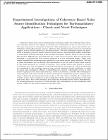| dc.contributor.author | Bennett, Gareth | en |
| dc.date.accessioned | 2012-06-21T10:19:50Z | |
| dc.date.available | 2012-06-21T10:19:50Z | |
| dc.date.created | 6-8 June | en |
| dc.date.issued | 2011 | en |
| dc.date.submitted | 2011 | en |
| dc.identifier.citation | Ian Davis, Gareth J. Bennett, Experimental Investigations of Coherence Based Noise Source Identification Techniques for Turbomachinery Applications - Classic and Novel Techniques (AIAA-2011-2830), 17th AIAA/CEAS Aeroacoustics Conference (32nd AIAA Aeroacoustics Conference), Portland, Oregon, USA, 6-8 June, AIAA-2011-2830, 2011, CD-ROM | en |
| dc.identifier.other | Y | en |
| dc.identifier.uri | http://hdl.handle.net/2262/63900 | |
| dc.description | PUBLISHED | en |
| dc.description | Portland, Oregon, USA | en |
| dc.description.abstract | Coherence based noise source identi cation techniques utilise the ordinary linear coherence function between two signals to identify the contribution of one or more sources to the noise measured at a location of interest. Such techniques can assess the relative contributions of broadband noise sources, which are the dominant noise sources in turboshaft engines, to the sound radiated at a far-field location. All such techniques require the placement of dynamic pressure sensors close to these sources. Experimental studies undertaken at the Engine Acoustics Branch of the German Aerospace Agency, DLR, as part of an EU FP7 project, TEENI, have provided data for a range of test scenarios. The test rig has been designed to represent the key acoustic elements of a real turboshaft engine. Each noise source identification technique were applied in a two noise source region scenario. The aim of these techniques was to identify the contribution of one or both of these noise sources to the noise measured at a sensor of interest. Test set-ups where each source is present in isolation were also investigated to provide benchmark auto-spectra. These benchmarks are compared to the resulting spectra from several coherence based techniques in order to assess each technique's efficacy in identifying the relative contribution of one or both source region(s) to the noise measured by a receiver of interest. A modal CSA technique is also proposed and tested, based on the ve-microphone conditional spectral analysis technique, which uses decomposed acoustic modes at the duct inlet to identify the contribution
of both of the source region(s) to the amplitudes of the modes propagating at the inlet end of the duct. The novel technique was tested for broadband noise source identification, by investigating how accurately it could identify the contributions of two broadband noise source regions to the modal content at the duct inlet. | en |
| dc.description.sponsorship | European Union. Seventh Framework Programme. EU commission grant agreement 212367. | en |
| dc.format.extent | CD-ROM | en |
| dc.language.iso | en | en |
| dc.relation.ispartofseries | AIAA-2011-2830 | en |
| dc.rights | Y | en |
| dc.subject | Turbomachinery | en |
| dc.subject | Noise Source Identi cation | en |
| dc.subject | Coherence | en |
| dc.subject | Turboshaft | en |
| dc.subject | Aeroengine | en |
| dc.subject | Helicopter | en |
| dc.subject | Broadband noise | en |
| dc.subject | Aeroacoustics | en |
| dc.title | Experimental Investigations of Coherence Based Noise Source Identification Techniques for Turbomachinery Applications - Classic and Novel Techniques (AIAA-2011-2830) | en |
| dc.title.alternative | 17th AIAA/CEAS Aeroacoustics Conference (32nd AIAA Aeroacoustics Conference) | en |
| dc.type | Conference Paper | en |
| dc.type.supercollection | scholarly_publications | en |
| dc.type.supercollection | refereed_publications | en |
| dc.identifier.peoplefinderurl | http://people.tcd.ie/bennettg | en |
| dc.identifier.rssinternalid | 74035 | en |
| dc.relation.ecprojectid | info:eu-repo/grantAgreement/EC/FP7/212367 | |
| dc.rights.ecaccessrights | OpenAccess | |
| dc.subject.TCDTheme | Smart & Sustainable Planet | en |
| dc.identifier.rssuri | http://arc.aiaa.org/doi/abs/10.2514/6.2011-2830 | en |
| dc.identifier.orcid_id | 0000-0002-1621-7533 | en |
| dc.contributor.sponsor | European Research Council (ERC) | en |
| dc.contributor.sponsorGrantNumber | 212367 | en |




